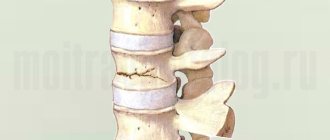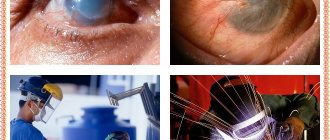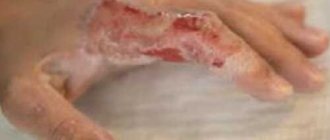In most cases, frostbite occurs without the appearance of severe pain and a person may not immediately pay attention to the changes that appear in the tissues. In this article, we will introduce you to the first signs of frostbite and ways to provide first aid to the victim. This information will help you avoid many mistakes when such injuries occur, and you will be able to provide adequate assistance to yourself or your loved ones.
Frostbite is injury to body tissue (even death) that is caused by cold exposure. Most often they occur in the winter season when there are severe frosts below - 10-20 ° C, but such lesions can also be observed during prolonged stay outside in windy weather and high humidity, when the air temperature is above 0 ° C. Most often, the fingers and toes, ears, nose or other most exposed areas of the body (arms, legs, face) are affected.
Staying outside for a long time in frosty weather can lead to general hypothermia and frostbite in exposed areas of the body.
Many factors can contribute to the occurrence of frostbite:
- clothing and shoes that are not suitable for the weather;
- tight, damp or wet shoes and clothing;
- prolonged stay in an uncomfortable position or immobile position;
- hunger;
- alcohol intoxication;
- smoking;
- sweating hands or feet;
- physical fatigue;
- previous frostbite;
- severe injuries with blood loss;
- the presence of chronic heart and vascular diseases;
- chronic vascular diseases of the legs;
- weakness of the body after serious illness.
The nature of changes in tissues damaged by cold depends on the level and duration of exposure to low temperatures. At – 10-20 °C, exposure to cold causes significant vascular spasm, which leads to a sharp slowdown in blood circulation and vascular thrombosis. As a result, the functioning of tissues is disrupted, leading to their destruction. When exposed to very low temperatures (below – 30 °C), total cell death occurs.
Signs of frostbitten feet
The first signs of frostbite on the feet include:
- Tingling, burning in fingers;
- Numbness of the skin of the feet;
- Difficulty, discomfort when moving fingers;
- Pain in the foot;
- Pallor of the skin of the affected area.
The longer a person is in the cold, the more obvious the numbness becomes, and the burning and pain fade into the background. This is due to the destruction of sensitive nerve endings under the influence of cold.
Note!
Persons with thrombosis, atherosclerosis, or damage to the peripheral nerves of the legs are not recommended to stay outside for a long time in cold weather. Sensitivity in their lower extremities is usually reduced, and the first signs of frostbite appear too late.
After warming the extremities, they become red or bluish, swell, the pain intensifies, and blisters may appear on the skin. Symptoms of local hypothermia depend on the degree of damage to the skin and deep structures of the leg.
How to avoid frostbite and hypothermia
To prevent frostbite and hypothermia in cold weather, the following rules should be followed:
Wear loose clothing and shoes that do not interfere with normal blood circulation.- When choosing clothes in severe frost, use the principle of layering clothing: under waterproof outer clothing, wear two sweaters, long johns or tights and warm trousers, double mittens, cotton and wool socks.
- When choosing clothes, take into account the fact that children or elderly people need more insulation. In children, thermoregulation is not yet sufficiently developed, and in older people it is already impaired.
- Before going out into the cold, be sure to eat to provide your body with the necessary energy.
- Thick and warm insoles should be placed in your shoes. It should always be dry.
- Do not go outside in frosty or cold windy weather without a hat, scarf and mittens.
- For long walks in cold weather, take with you replacement mittens, socks and a thermos of tea.
- In windy and frosty weather, use protective cream for your face and hands.
- When it is cold, do not wear metal jewelry and avoid contact with any metal objects.
- Take special care to insulate previously frostbitten areas of the body, since repeated cold damage occurs faster and is more difficult to tolerate.
- Hide from the wind, as cold air flow causes hypothermia faster.
- When going out into the cold, you should not drink alcohol or smoke. Severe frostbite of the III-IV degree in most cases occurs in persons in a state of intoxication, and smoking (especially in experienced smokers) impairs peripheral circulation and cold injuries occur faster.
- If the car breaks down in an unfamiliar place or far from populated areas, then you need to stay in the car, call for help by phone or wait for another vehicle to appear.
- At the first sensation of hypothermia or freezing of the extremities, go into a warm room to warm up and inspect hypothermic areas.
- After returning home, be sure to examine your entire body and make sure there is no frostbite.
Frostbite is a dangerous injury and, in severe cases, can lead to long-term disability and disability. When their first signs appear, you should immediately stop exposure to cold, provide the victim with first aid and take him to a doctor to prescribe the correct treatment.
Pediatrician E. O. Komarovsky talks about first aid for frostbite:
Video lecture on the topic “First aid for frostbite”:
Health-saving channel, doctor of the highest category Vasilchenko I.V. talks about frostbite:
Rating: (votes - 3 , average: 4.33 out of 5)
Degrees and symptoms
There are 4 degrees of frostbite of the lower extremities:
- Reversible damage to the upper layers of the epidermis. The skin turns pale, its sensitivity decreases, tingling and tingling appear in the fingertips. After warming up, moderate pain, itching, burning in the legs occurs, and the skin acquires a red-blue tint. After a few hours or days, the surface layer of the skin peels off.
- The deeper layers of the skin are damaged, causing blisters filled with yellow or reddish fluid to appear on the surface of the feet. After warming up, the legs become bluish-burgundy, severe pain appears, which requires taking analgesics. Sometimes the nail plates come off. With proper treatment, degree 2 frostbite also goes away for the toes without consequences: the nails grow back, the skin is completely restored, since its growth layer is not affected.
- Deep damage to the skin and subcutaneous fat is accompanied by the formation of blisters with reddish liquid and the formation of areas of necrosis - tissue death. They look like islands of gray or bluish color. Nails come off permanently or become severely deformed. Symptoms of general hypothermia of the body are also common - decreased blood pressure, decreased pulse, general weakness, drowsiness.
- Frostbite of the deep structures of the toes - muscles, ligaments, bones. Dry gangrene develops - the foot loses sensitivity, turns black, and a clear boundary appears between healthy and necrotic tissues. With the development of infectious complications, wet gangrene is observed - the foot swells greatly, hurts, blisters with fetid contents form, the skin has an uneven, “marbled” color. Due to intoxication, the general condition suffers: the temperature rises, the functioning of internal organs and the brain is disrupted.
Whether the mild stage of frostbite will progress to necrosis depends on the correct provision of first aid at the initial stage of hypothermia.
Degrees of frostbite
The impact of low temperatures may be insignificant; in this case, body tissues can easily recover. However, cases leading to human death are also possible. More often this occurs due to ignorance of the signs of cooling and the danger that each degree of frostbite can pose. The basics of PMP (first aid) will help. Proper first aid and basic rules of behavior in the cold, which even every schoolchild should know, are necessary to avoid deaths.
Depending on the degree of tissue damage, frostbite can be:
- First degree - pale skin, tingling sensation, numbness. After warming, the tissues are easily restored.
- Second - the skin turns white, itching and burning are felt. When warmed, it acquires a brown or bluish tint, and bubbles with liquid appear on the surface of the skin when warmed. At this stage, changes in tissues are reversible with proper PMP.
- The third degree is characterized by a sharp decrease in blood pressure, impaired circulation and a decrease in body temperature to critical levels. After warming up, the skin has a bluish-black color, the sensitivity of the frostbitten area is lost, and after a couple of days severe pain is felt.
- The fourth degree is characterized by a high probability of death, necrosis of cells and sometimes bones occurs.
In medical practice, periods of frostbite are considered: the pre-reactive period of the lesion, early and late. The pre-reactive period is characterized by not too long exposure to cold. The reactive period is characterized by severe tissue damage, the late period is associated with a painful recovery process, and in some cases, if treatment is unsuccessful, with amputation.
First aid for frostbitten toes and thumb
What should you do first when signs of frostbite appear on your toes? In case of frostbite of the 1st degree, the following sequence of actions must be followed:
- Take the victim to a warm room.
- Replace cold, wet clothes with dry, warm ones.
- Give hot liquid to drink.
- Warm your feet gradually. First, they should be immersed in water with a temperature of no more than 20 ˚C, then within 40 minutes it is raised to 40 ˚C.
- If there is no water in the room, then with the first degree of frostbite, you can carefully rub the skin of your feet with a warm cloth.
- After warming up the victim, it is better to put him to bed, leaving his legs in an elevated position (on a pillow).
- If intense pain occurs, it is allowed to give an anesthetic drug.
“Iron” frostbite and first aid for it
In winter, cases of “iron” frostbite often occur, which occur when warm skin comes into contact with a cooled metal object. Such cold injuries are especially often observed in children who grab iron objects with their hands or try to lick them with their tongue. If the victim tries to “break away” from the shackles, then in most cases a large wound appears at the site of frostbite. In this case, the person experiences severe pain.
If such a deep injury occurs, the wound must be washed with warm water and disinfected with a 3% hydrogen peroxide solution. After this, the bleeding should be stopped. To do this, you can use a hemostatic sponge or apply a pressure bandage to the affected area (fold a sterile bandage in several layers and press it tightly until the bleeding stops to the wound). If extensive wounds appear, you should consult a doctor.
If the victim is afraid to tear himself away from the iron object, then this procedure must be carried out correctly. To do this, use warm (but not hot!) water. It is watered on the place of “sticking” until the frozen area is completely freed. After this, the wound is treated and bleeding is stopped.
Assisting with deep frostbite
It is impossible to purposefully warm your feet at 2-4 degrees of hypothermia. You need to make an insulating bandage from gauze and cotton wool. Apply a bandage, cotton wool, another bandage, foil, and polyethylene in layers. This bandage retains heat and warms up more slowly. Otherwise, there is a risk of increasing the breakdown of affected tissues and general intoxication of the body.
Frostbitten limbs should be kept at rest. If muscle fibers are damaged and foot movements are difficult, it is better to fix them with an improvised splint (piece of cardboard, plywood, plank).
In case of severe frostbite, you should first call an ambulance. You can begin the manipulations described above while you are waiting for her arrival, or if medical assistance is unavailable for some reason. The sooner the patient receives specialized treatment, the better.
Advice!
With frostbite of 2-4 degrees, it is usually impossible to do without analgesics. There is no point in enduring intense pain; it is better to immediately take an analgin or ketorol tablet.
Periods of development of frostbite
Since the main factor in frostbite is time, the effectiveness of first aid for frostbite depends on the time elapsed from the hour of traumatic exposure to the time of application of warming procedures, and also depends on the stage and degree of frostbite.
There are two main time periods during which changes occur in the cells and tissues of the affected area:
- The pre-reactive period of frostbite is a hidden period of the negative impact of frost, calculated from the moment of injury until the start of the warming process
- Reactive period of frostbite - develops from the moment the damaged tissues are warmed. In turn, the period of time for warming up after frostbite is divided into:
- early (reversible) reactive period lasting up to 10-12 hours , when complete restoration of microcirculation in tissues without consequences is most likely
- late (irreversible) period when frostbite is accompanied by death (necrosis) of cells of damaged tissues
First aid mistakes
Some procedures that are sometimes recommended to be performed during hypothermia can cause serious harm:
- Warming up too quickly - a sharp resumption of blood flow through the vessels of the skin will accelerate the process of tissue destruction;
- Warming your feet by an open fire. The temperature sensitivity of frostbitten skin decreases - the likelihood of getting a burn increases;
- Rubbing areas of frostbite covered with blisters. This will increase the area of damage, and there will be a chance of infection;
- Rubbing the skin with snow - direct contact with a cold object will only aggravate the disorders;
- Self-piercing or removing blisters increases the risk of infection;
- Applying any ointments or creams to the blisters without first consulting a doctor;
- Drinking alcohol instead of warm drinks. Ethyl alcohol does not warm the body, but only creates the illusion of warmth due to the expansion of peripheral blood vessels.
This should not be done under any circumstances
Many people do not know what not to do if they have frostbite. By following incompetent advice, victims risk complicating the course of the disease and the subsequent treatment process by adding inflammation, and in the worst case, getting blood poisoning.
The following actions are not allowed in case of frostbite:
- ignore damage received
- rub the injured area
- quickly warm your fingers with hot water
- drink coffee, alcoholic drinks
- use frostbite ointment, oils, antiseptics without consulting a doctor
- rub with snow, alcohol
- warm yourself by the fire
- use a hair dryer
- pop bubbles
Warming cold-stricken limbs with water at home is only permissible in mild cases. In this case, the temperature of the liquid should not exceed 24-30° C. For children and the elderly, first aid for frostbite should be provided only in a medical institution, and in difficult cases in a hospital setting.
Treatment of frostbite toes
Only a doctor can help with frostbite of 2-4 degrees. Treatment can be conservative or surgical. Conservative therapy involves the use of the following medications:
- Analgesics, anti-inflammatory drugs - analgin, dexalgin, ketorol. They reduce inflammation, swelling, pain;
- Antispasmodics – no-spa, papaverine – normalize vascular tone, improve blood flow;
- Antiplatelet agents (aspirin, cardiomagnyl) prevent the development of thrombosis;
- Antihistamines (tavegil, suprastin, claritin) reduce swelling, itching, burning;
- Local preparations in the form of creams and ointments that accelerate healing and prevent infectious complications, for example, ointments for frostbite of the feet Baneocin, Actovegin, Bepanten.
Other drugs are used if necessary if the patient's general condition suffers. These are drugs that regulate the functioning of the cardiovascular and respiratory systems, intravenous solutions that remove decay products from the body, narcotic analgesics for severe pain, antibiotics for the treatment of bacterial infections.
Classification of frostbite by severity
In modern medical practice, there are four degrees of frostbite, each of which is characterized by certain symptoms:
- Frostbite 1st degree . Symptoms: itching, numbness, pins and needles sensation on the skin, tingling, visual pallor of the upper layer of the epidermis, redness of the skin after warming.
- Frostbite 2nd degree . Symptoms: loss of sensitivity, cyanosis of individual areas of the skin or the entire frostbitten part of the body, intense pain when moving, warming the fingers and affected limbs, the formation of blisters with serous fluid in the reactive period.
- Frostbite 3rd degree . Symptoms: formation of epidermal blisters with bloody exudate and a purplish-blue bottom, intense and prolonged pain, necrosis (death) of the skin, subcutaneous tissue and underlying layers of soft tissue, rejection of necrotic tissue followed by granulation, scarring and epithelization.
- Frostbite 4th degree . Symptoms: total extensive tissue necrosis at the warming stage, damage to soft tissues, joints and bones, intensely increasing swelling, severe pain in the reactive period, complete loss of sensitivity.
First aid for frostbite and hypothermia depends on the depth of damage by cold to the layers of the skin, subcutaneous tissue and other tissues. Mild frostbite almost always goes away safely if you do not make serious mistakes aimed at accelerating or imaginary warming of the body.
You should know that treatment of frostbite at home is permissible only with 1st degree of damage and a reversible process of restoring blood circulation. All other severe injuries risk infection in the injured tissue and the development of an inflammatory process, and therefore must be supervised by professionals. Even 2nd degree frostbite if not properly cared for can lead to amputation of fingers, ears and other damaged parts of the body. However, correctly provided pre-medical first aid directly affects the favorable outcome of further treatment of frostbite.
Folk remedies
Treatment of frostbite of the toes with folk recipes at home is only possible as an addition to the main therapy prescribed by the doctor. They are used while maintaining the integrity of the skin and only after the doctor’s permission.
The following folk remedies are widely used:
- Foot baths based on chamomile, celery or oak bark are used to gradually warm the extremities with 1 degree of hypothermia. Unlike ordinary water, they improve skin regeneration and have antibacterial properties;
- Compresses made from chamomile or calendula decoction. They are applied to the affected areas 3 times a day for 20-30 minutes for faster healing of damaged skin;
- Aloe juice or potato juice is applied directly to frostbitten areas 3-5 times a day, which not only restores the skin, but also soothes it, reducing pain, burning, itching;
- Sea buckthorn or olive oil can be applied to areas of the skin without open wounds. Also, a thick ointment is prepared based on olive oil with the addition of beeswax and the yolk of a boiled egg. This is an effective remedy for rapid wound healing.
What to do if you have frostbite
Everyone should remember that proper first aid for hypothermia can minimize the effects of cold on the body. Unfortunately, not everyone is aware of the correct actions to take in case of frostbite. People make mistakes that aggravate the condition of the body. To know what actions will be correct, you need to remember the causes and signs of injuries caused by frost. They can appear even after a long winter walk.
Signs of frostbite
Low temperatures and a combination of accompanying factors can lead to hypothermia, which subsequently leads to frostbite of tissues. First, the body temperature decreases (less than 35 degrees), all processes slow down, including the heartbeat. Frostbite can occur with prolonged exposure to low temperatures. Everyone should know what the symptoms of skin frostbite look like:
- whitening, loss of sensitivity of the skin;
- a slight tingling sensation (in the first degree);
- the onset of the second degree of cold injury is characterized by the appearance of blisters on the skin, similar to a burn (within 12 hours after warming up);
- third degree is characterized by darkening of the skin, which indicates the beginning of tissue death.
- Providing primary care for bruises and hematomas at home - algorithm of actions and treatment
- Providing first aid for arterial bleeding
- Rules for rescuing and providing emergency first aid to a drowning person - an algorithm for resuscitation actions
Causes of frostbite
An obvious cause of cold injury is the effect of cold temperatures on the body. Some causes of hypothermia and frostbite are tolerated by people simply out of ignorance, because even when exposed to slightly low temperatures, you can get frostbite. The process of hypothermia can be triggered by:
- alcohol intoxication;
- overwork of the body, hunger;
- insufficiently properly selected clothing (synthetic fabrics, tight-fitting items that interfere with blood circulation);
- wearing tight shoes that leave no room for air;
- wet clothes at high air humidity;
- long stays outside in strong winds.
Complications and consequences
Stages 1 and 2 of local hypothermia usually occur without consequences. If you open the blisters yourself, scars may remain in their place.
The consequences of grade 3 frostbite are scars on the skin in areas of necrosis, deformation of the fingers due to rough scar tissue, and abnormal nail growth.
In grade 4 lesions, individual toes or the entire foot must be amputated due to gangrene, which leads to limited mobility and disability.
Severe frostbite can be accompanied by the following complications:
- Infectious process;
- Vascular thrombosis;
- Increase in area of gangrene;
- Extensive growth of scar tissue (keloid scars);
- Sepsis – infection enters the bloodstream and spreads throughout the body;
- Severe general hypothermia, dysfunction of vital organs.
With the development of sepsis or systemic hypothermia, death is possible.
When is surgery required and how is it performed?
The operation should be done at stage 3 or 4 of frostbite. At stage 3, necrectomy is performed - removal of dead tissue. In large areas of necrosis, the wound is not sutured immediately; drainage is often left for several days, through which the inflammatory fluid flows out.
The fourth stage requires amputation of part of the limb, since with the development of gangrene the tissue becomes completely non-viable. The easiest way to determine the level of amputation is with dry gangrene, when “dead” tissue is visible to the naked eye. With wet gangrene, the inflammatory process can spread up the leg and often requires amputation at a higher level. After complete healing of the stump, the issue of prosthetics is decided.
Features of frostbite of body parts
Frostbite of individual parts of the body has its own characteristics and course depending on the degree of cold damage.
Hands
The upper extremities are more likely than other parts of the body to suffer from frostbite. This is facilitated by the thinner structure of the tissues and the close proximity of the vessels, as well as ignoring the wearing of mittens or gloves during frost or simply too cold, windy and humid weather. In the first degree of frostbite, the fingers and part of the hand turn white, a slight tingling and burning sensation of the skin is diagnosed, and during the process of warming up, the upper extremities turn red very quickly, a strong burning sensation is felt in the soft tissues, and the fingertips lose sensitivity for 1-2 days;
Legs
The lower extremities suffer from frostbite less often than the hands, but the main provoking factor in the development of cold injury is uncomfortable, tight and wet shoes, as well as the lack of active movement.
The victim rarely pays attention to mild forms of frostbite on the legs, in contrast to the hands, which are used more often in everyday life. The result is sad statistics - the largest number of amputations due to gangrenous processes in soft tissues occur in the lower extremities;
Head
Frostbite of the head deserves special attention. If in mild forms of cold damage it is mainly the ears, nose, cheeks and face that suffer, then, starting from the 2nd stage of frostbite, the risks to the health and even life of the victim increase significantly, since the pathology is often combined with hypothermia of the head, leading to the development of inflammation of the meninges ( its soft external structures). Moreover, if assistance is not provided and the temperature of this part of the body drops to 24 degrees Celsius, the work of the elongated structure of the above-mentioned organ is disrupted, which can lead to respiratory arrest and clinical death.
Preventative measures for frostbite of the feet
To minimize the risk of complications, you need to follow the basic rules in the cold:
- Don't buy shoes that are too tight or narrow. It is best to choose loose boots or boots that you can wear a warm sock under – multi-layered clothing retains heat better.
- When staying in the cold for a long time, try to move more: walk, stand on tiptoes, jump.
- Dry your shoes from the inside before each time you go outside.
- Do not drink alcohol before a long walk in the cold - it disrupts thermoregulation and reduces sensitivity.
- Leaving the house after a heavy snack will make it easier for your body to produce heat.
- Monitor the condition of the feet of people who cannot control it on their own. These are young children and old people in whom frostbite occurs most often. Place your palm on their shoe and ask them to wiggle their toes. The inability to actively move or the appearance of pain should alert you.
Every person should know how to determine the degree of damage due to frostbite on the feet and what to do in this case. Timely and competent first aid can save not only health, but also human life. Follow simple precautions - then frostbite will bypass you.
Signs of general cooling
With prolonged exposure to the cold, not only tissues can be damaged, but also general hypothermia occurs, accompanied by a decrease in general temperature below 34 ° C. The same factors that increase the likelihood of developing frostbite can contribute to the development of this condition.
General cooling is divided into three degrees:
- mild - the temperature drops to 32-34 ° C, the skin is pale or slightly bluish, “goose bumps”, speech becomes difficult, chills begin, blood pressure rises slightly or remains normal, the pulse slows down to 60 beats per minute, breathing is not disturbed;
- average - the temperature drops below 32 ° C, depression of consciousness appears, the gaze becomes meaningless, sudden drowsiness occurs, the skin is cold, pale, bluish (sometimes marbled), the pressure decreases slightly, the pulse slows down to 50 beats per minute, breathing becomes shallow and rare ( up to 8-12 breaths per minute);
- severe - the temperature drops below 31 ° C, there is no consciousness, vomiting and convulsions appear, the skin is cold, pale and bluish, the pressure decreases significantly, the pulse is weak and slows down to 36 beats per minute, breathing becomes very rare (up to 3-4 breaths per minute). minute).
Frostbite treatment and medications
Conservative therapy for frostbite involves treatment in a hospital setting - independent selection of drugs and instrumental methods for getting rid of the consequences of moderate or severe cold damage is strictly prohibited. A specific therapeutic regimen with the names of drugs, duration of treatment, etc., is developed by a qualified doctor based on vital signs, the severity of the injury and other factors.
Basic drugs and medications for frostbite of the extremities:
- Analgesics - both classic NSAIDs and drugs of the narcotic spectrum, depending on the severity of frostbite and the strength of the pain syndrome;
- Antispasmodics. Used to normalize oxygen supply to soft tissues and improve muscle tone;
- Antiplatelet agents and anticoagulants. Prescribed to prevent thrombosis and blood stagnation during frostbite.
- Vasodilators and cardiovascular drugs. Used to normalize blood circulation, as well as prevent the development of thrombosis and heart attacks;
- Angioprotectors. Restoration of blood vessels after exposure to low temperatures;
- Detoxification drugs. Get rid of toxins and decay products in case of severe forms of frostbite;
- Other medicines for life-saving indications - from antibiotics intended to combat secondary bacterial infections to anti-tetanus serums.
Procedural techniques (used if necessary for health reasons):
- Artificial ventilation;
- Installation of heart rate drivers;
- Droppers with warmed saline solutions and glucose;
- PN-sympathetic blockade;
- Vacuum drainage;
- IR irradiation;
- Oxygenation in a hyperbaric chamber;
- Complex physiotherapeutic procedures approved for use during the reactive period after frostbite - electrophoresis, UHF, biogalvanization, ultrasound, etc.
Causes of frostbite
According to statistics, most of the people who received frostbite were intoxicated. Other factors that may lead to these consequences include:
- malaise, physical fatigue and hunger,
- chronic diseases of the cardiovascular system,
- wet clothes, increased body sweating,
- injuries resulting in severe blood loss,
- staying in one position for a long time without moving.
Freezing leads to spasm of small vessels, after which blood circulation slows down, the work of tissue enzymes stops, and cell death occurs.
Features of frostbite: pre-reactive and reactive periods
The first and main manifestation indicating cold damage to tissues is circulatory disorders. Frostbite of the extremities is accompanied by desolation of the main arterial trunks and disruption of tissue trophism. The course of frostbite corresponds to two periods, pre-reactive and reactive.
The pre-reactive period is characterized by a paucity of symptoms, as a result of which frostbite occurs imperceptibly, with the absence of a subjective type of sensation on a pronounced scale. In some cases, some tingling or mild soreness may occur. Objectively, the skin becomes pale and cold.
The reactive period begins after frostbitten tissues begin to warm up. Symptoms appear depending on the depth covered by the lesion within the skin, as well as on associated complications. Uncomplicated frostbite corresponding to degree I with the manifestations of symptoms noted above lasts for 4-6 days, after which it goes away.
With II degree frostbite, the changes corresponding to it are based on the intensification of the symptoms of I degree frostbite; these changes persist for a period of 2 to 3 weeks, after which they gradually disappear. Due to the development of infection in this case, all manifestations are aggravated, the body also responds in the form of a general reaction with a change in blood composition, an increase in temperature, etc., against the background of which the outcome of the process and its duration can be determined by the individual forces of the body, as well as virulence of the affecting infection.
Stages III and IV are gangrenous in nature with accompanying infection. If frostbite occurs in accordance with the dry type of gangrene, then there is a gradual mummification and drying of the tissues, acquiring a dark blue color, with granulation in the area of living tissues and with the absence of general symptoms in its expressed version. Removal of dead tissue results in a scar. If frostbite occurs in accordance with the type of wet gangrene, then there appears pronounced swelling of the tissues, fever, insomnia, headache, symptoms of intoxication, etc. In case of frostbite within the indicated degrees, it is quite difficult to determine the boundaries of the tissues that have undergone necrosis during the first days after this. this becomes possible by the third or fourth week, as a result of which surgical treatment in these cases is based on preliminary waiting.
Considering that the pre-reactive period is characterized by very sparse symptoms, it is quite difficult to determine the actual degree of depth of tissue damage and microcirculation disorders. Regarding the tactics that first aid implies for frostbite of the extremities, there are two main points of view related to the specified pre-reactive period.
The first of them is based on the fact that the sooner the influence of the tissue-damaging factor (cold itself) is stopped, the better the effectiveness of the applied treatment measures will be. As for the second point of view, it is somewhat more modern and is based on the fact that it is necessary to ensure an increase in interstitial temperature, accordingly, increasing the need for tissue oxygen, but this must be done after the restoration of microcirculation. In this case, tissue warming will occur almost independently, which will be ensured by the influx of warm blood while simultaneously restoring energy metabolism in the cells.
The stated principles allow us to highlight the following important points:
- a complete and quick way to ensure the restoration of microcirculation, as well as providing effective first aid for frostbite (especially for deep lesions) during the pre-reactive period is possible only with intensive treatment within a hospital setting;
- due to the fact that the course of the pre-reactive period does not allow us to reliably determine how large the scale of the lesion is, it is important to consider any type of frostbite as a potentially deep lesion, again requiring hospitalization;
- any of the methods designed to provide active heating of the affected limb poses a risk of hypoxia in the affected tissues, which is why such methods must be used only under strict, and ideally, under instrumental control of the general state of tissue microcirculation and oxygenation.
When to see a doctor
Ideally, even in the mildest stage of frostbite, after undergoing the warming procedure, it is advisable to see a therapist who will diagnose the patient’s condition and adjust the further course of treatment. It is mandatory to immediately seek qualified medical help in the following cases:
- 2 and higher degrees of frostbite. Are there blisters with clear or bloody fluid or severe swelling? Have you not felt your skin for more than 2 hours or has it turned a deep bluish color? Are there other symptoms of deep-seated soft tissue lesions? Call an ambulance;
- Ages up to 12 and after 50 years, regardless of the stage of frostbite. Children and the elderly are at particular risk; they require medical monitoring, regardless of the stage of frostbite;
- Cold damage to an area larger than the palm of an adult. This localization will not recover on its own and can provoke the development of numerous complications;
- No effect of home therapy for frostbite.
Stages
To provide first aid, it is important to correctly determine the degree of tissue damage. Frostbite is divided into several stages.
- Frostbite of the lower extremities: what to do?
- 1st degree. Pallor of the skin, which after warming takes on a purplish-red appearance. The appearance of slight swelling in the damaged area. Painful sensations are accompanied by tingling, burning, followed by numbness, followed by itching and pain of varying intensity. Symptoms go away on their own within a week. Peeling of the skin is possible.
- 2nd degree. Whitening of the skin in the area of damage, loss of sensitivity. 12 hours after the injury, blisters filled with cloudy liquid appear. After warming up, intense pain, itching and burning occurs. The recovery period takes 10-14 days. The skin is restored in full without scarring or granulation.
- 3rd degree. The skin is white, with a yellowish tint. Warming leads to severe pain. At the site of frostbite, blisters with bloody filling form, when opened, a blue-purple bottom appears, insensitive to irritation. The nail plates are black and purple. The damaged skin dies completely. Its rejection lasts 14-19 days with the formation of ulcers. After 2 weeks, scarring begins, lasting about a month and ending with the appearance of scars and granulations.
- 4th degree. The depth of the lesion often reaches bones and joints. Soft tissues are completely destroyed. Skin color is bluish with a marble pattern. After warming, rapidly increasing swelling appears. Watery blisters are completely absent, and sensitivity is lost. Dead tissues are not regenerated. They gradually mummify and are rejected.
It is impossible to accurately state the degree of injury at the initial stage. The severity can be determined after a few days, after the first signs of frostbite appear and tissue begins to be torn away.
First of all, you need to carry out a set of necessary emergency warming measures and then be sure to deliver the victim to a surgeon or traumatologist.
How does this happen?
Frostbite of the extremities, contrary to popular belief, is possible not only at particularly low temperatures. The medical literature describes cases of frostbite of 2-3 degrees in conditions of zero degrees, which is understandable.
The mechanism of frostbite of the extremities has been sufficiently studied. With a local decrease in body temperature, a narrowing of small peripheral vessels and large blood supply structures occurs. The result is heat loss and insufficient blood circulation in the legs. Atrophic and degenerative changes occur. The longer a person is in the cold, the more severe the consequences. It all ends with the death of tissue affected by ischemia: necrosis.
What else do you need to know about such a formidable condition?
Treatment
Treatment is possible at home if we are talking about 1-2 degrees of damage. Initial activities are required. At stages 3-4, a combination of conservative and surgical treatment is indicated.
Appointed:
- Analgesics.
- Antispasmodics.
- Vitamins.
- Ointments based on zinc. Necessary to slow down the process of necrosis, if any.
- Angioprotectors. Allows you to restore the normal functioning of blood vessels.
- Necrotizing drugs. Accelerate tissue necrosis and delimitation of healthy areas during the fourth stage of frostbite.
- Anticoagulants and many other types of medications that prevent blood clots and improve blood flow.
Surgical treatment consists of excision of affected tissue affected by necrosis.
Thus, frostbite of the lower extremities is common. You need to know what to do in each specific case. This way, the potential patient will be fully armed.
Classification of frostbites according to ICD 10 and their degrees
Cold tissue damage can be superficial and deep, local and covering large areas of the body. According to the International Classification of Diseases, 10th revision (ICD 10), degrees of frostbite are coded:
- T 33 (superficial frostbite);
- T 34 (frostbite with tissue death);
- T 35 (frostbite of several parts of the body at once).
Cold injury can occur not only when the body is exposed to sub-zero temperatures.
There are often cases when frostbite of the lower extremities occurs at +4, +6, +8 and above °C. This type of damage is observed among fishermen who wear damp shoes for a long time, and soldiers who spend days in trenches without the opportunity to dry their boots and warm their feet. Hence, this form of frostbite acquired the name “trench foot.”
Factors influencing the possibility of getting frostbite are: prolonged exposure to cold winds and low temperatures, childhood and old age, the presence of diseases (mental disorders, cardiovascular diseases and others), the influence of alcohol and drugs.
Based on the depth and area of the lesion, there are 4 degrees of frostbite. It is possible to determine the severity of the injury only 5-10 days after receiving it. This is due to the fact that in the first period (pre-reactive period), before the damaged areas are warmed, the skin and tissues look quite viable, but after they are heated (reactive period), changes appear in the frostbitten parts of the body. And sometimes the processes of transformation can be very rapid and scary. In grades 1 and 2, symptoms are accompanied not only by external changes, but also by pain, burning, and itching. In stages 3 and 4, due to tissue necrosis and damage to nerve endings, the victim loses sensitivity and does not feel pain at the site of the lesion.
The most common places affected by frostbite are the face, arms (hands), legs (fingers), nose and ears. Less commonly, frostbite occurs on the lower leg, thigh, buttocks, and abdomen.
Clinical picture
Symptoms directly depend on the degree of frostbite. The heavier it is, the more pronounced the destruction and the less the patient feels (nerve endings die, causing a decrease in tactile sensitivity to almost zero) .
The following degrees and their corresponding symptoms are distinguished:
- First degree. Manifestations are minimal, occur spontaneously and are characterized by intensity. Only the top layer of skin is affected. Sensitivity is completely preserved. There is pallor of the skin, which is then replaced by sharp redness.
- Second degree. There is damage to the dermis (middle layer of skin), partially to the hypodermis. Patients note intense tingling, nagging and aching pain. A bluish discoloration of the skin occurs, which is then replaced by redness. Large blisters filled with intercellular fluid form. They open on their own within 3-15 days from the moment of occurrence without scarring. This is an intermediate stage of frostbite and is still not dangerous to the life and health of the patient.
- Third degree. The signs are sufficiently pronounced. This is already dangerous frostbite, which can cause irreversible changes in body tissues. The skin becomes dark brown or purple in color. Sensitivity is completely absent. Areas of necrosis are noted. Treatment is predominantly surgical with excision of the affected tissue. Such wounds heal only with the formation of intense scars.
- Fourth stage. The tissues of the lower extremities freeze completely and die. The skin is black or gray-black. Urgent surgical intervention is required to avoid severe purulent complications. Sensitivity is completely absent, as well as symptoms, since the nerve endings are necrotic.
In all cases, a certain degree of attention is required on the part of the patient himself. You need to note the symptoms and consult a doctor as soon as possible. With such problems, it is recommended to go to the emergency room or call an ambulance .
Symptoms of frostbite
Symptoms differ depending on the period of frostbite:
- Before warming up (pre-reactive period) - at this time a tingling and burning sensation is felt in the affected areas of the body. The feeling of cold is gradually replaced by loss of sensitivity. The skin at the site of frostbite becomes pale, with a bluish tint. The limbs stop moving and “turn to stone.”
- After warming up (reactive period) , the affected area becomes painful and swelling develops. Subsequently, inflammation and signs of tissue death appear.
Immediately after warming the frostbitten area, it is impossible to determine the severity of the lesion; sometimes the picture becomes clear after a few days. There is a classification of frostbite based on the depth of penetration of cold damage into the tissue.
Degrees
Frostbite of the extremities can occur at a temperature of -10 degrees. In medicine, there are 4 degrees according to the area of damage, symptoms and the possibility of recovery.
The first degree is the mildest, characterized by tingling in the limbs. The skin begins to turn white. Pain and redness also appear.
In the second degree, the fingers and toes begin to turn blue, blisters appear on the surface of the skin, and the painful sensation intensifies. With timely assistance, tissue restoration is possible without complications.
Frostbite of the extremities of the 3rd degree manifests itself in the form of darkening of injured tissues. The formed blisters begin to fill with blood. After healing, marks and scars remain on the surface of the skin.
The last degree is the most dangerous and is characterized by the spread of tissue damage to the deeper layers of the epidermis, affecting bone tissue.
The limbs become completely numb, darken and swell. Frostbite of the fingers of the 4th degree can lead to the loss of limbs, since the affected tissues are not restored.
Providing assistance in the initial period
For the mildest first degree of frostbite, hospitalization is not required; it is enough to follow the first aid recommendations described above and not go out into the cold for the next few days.
Based on the characteristic symptoms, it is necessary to determine the stage of the lesion before taking first aid measures for frostbite. If difficulties arise, the victim is sent to the hospital so that doctors can tell exactly how serious the injuries are. In any situation, a child with frostbite is referred to a doctor.
Warming the extremities
There are two main methods of warming up:
- Bring it closer to a warm area of the body - the stomach or armpits - or clasp it with your hands, breathe, massage.
- Place in a container with warm water (no more than 37°C). Later, add a little boiling water, but the temperature cannot be exceeded 40°.
What should you do outside?
If there is loss of sensitivity and numbness in the limbs while still on the street, it is necessary to take a number of actions to prevent complications.
These include:
- Wear gloves or mittens. The affected area of skin needs to be warmed. If you have frostbite in your lower extremities, you must actively move your toes. This will help increase blood circulation and avoid damage to the deep layers of the epidermis. Place your hands in your armpits;
- Go into a warm room. The best option is to stay indoors for at least 10 minutes;
- On the way to the nearest store or home, it is recommended to make active movements. You can run, clap your hands, wave your arms.
Such actions help to prevent damage to large areas of the skin and increase blood circulation in the vessels. It is strictly forbidden to rub injured limbs with snow, as this can lead to serious complications. When frostbite occurs, blood vessels also suffer. They become more fragile and can become injured when exposed, which will lead to poor circulation and the formation of blood clots.
First aid for burns
First aid for burns consists of eliminating the negative factor: you need to move away the source of electric current, wash off the chemical, cover the body from the sun, etc.
You can reduce the pain from a burn by using cold water or an ice pack, this will help reduce the severity of the damage. Apply a dry, sterile dressing, such as a bandage or clean cotton cloth, to the affected surface.
Treatment of burns
A traumatologist will treat the affected area.
For example, a wound resulting from a chemical burn is treated with a neutralizing substance (if the burn was caused by lime, then glucose is used).
Next, the doctor removes part of the non-viable skin and adhered fragments of clothing from the wound, removes blisters, and applies a dry sterile bandage or ointment mesh bandage to the wound. When treating burns, painkillers, a course of antibiotics, and a tetanus shot are prescribed.











